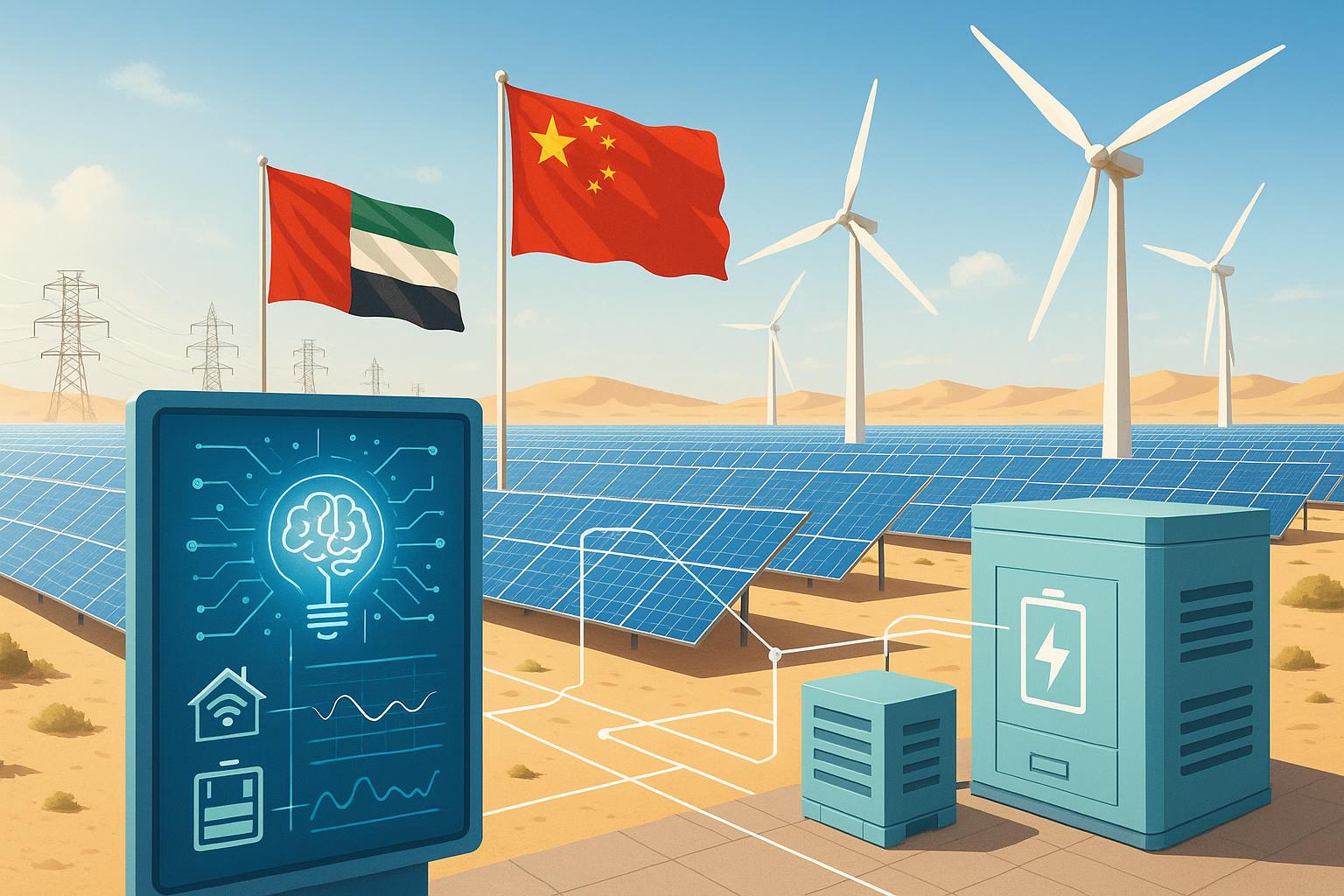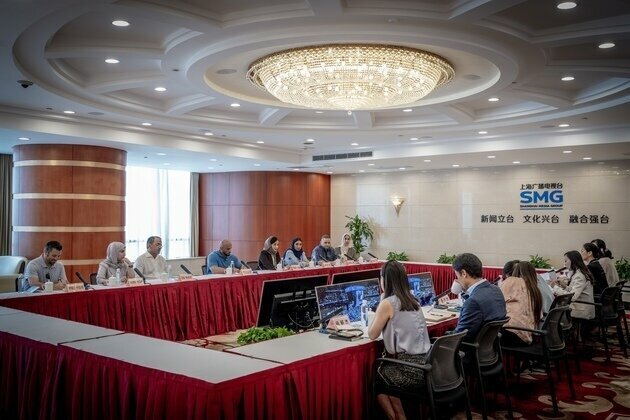The Geopolitics of AI: Navigating the US-China Rivalry in the Gulf
Introduction: The growing global competition in AI and its impact on the Middle East.
The 21st century has ushered in an era defined by technological competition, with Artificial Intelligence (AI) emerging as a pivotal battleground for global influence. As nations race to harness the transformative power of AI, the geopolitical landscape is being reshaped, creating new alliances, rivalries, and strategic imperatives. This dynamic is particularly evident in the Middle East, a region historically central to global energy markets and now increasingly vital for its strategic location and burgeoning digital ambitions. The Gulf states, notably the United Arab Emirates (UAE), find themselves at the nexus of this technological contest, navigating the complex interplay between established Western powers and rising Eastern giants. The strategic importance of the Middle East, once primarily defined by its hydrocarbon reserves, is now being recalibrated to include its potential as a hub for digital innovation and a crucial market for advanced technologies.
AI is not merely a technological advancement; it is a fundamental driver of economic growth, national security, and societal progress. Its applications span from advanced surveillance and defense systems to smart cities, healthcare, and renewable energy management. Consequently, control over AI capabilities translates directly into strategic advantage, prompting major global players like the United States and China to aggressively pursue dominance in this field. This pursuit often extends beyond their borders, as both nations seek to forge partnerships, secure supply chains, and establish technological ecosystems in key regions. The competition is not just about who develops the most advanced algorithms, but also about who controls the infrastructure, data, and talent necessary to deploy and scale these technologies globally. This global scramble for AI leadership inevitably draws in nations with the ambition and resources to participate, such as the UAE.
For the Middle East, and specifically the UAE, the global AI race presents both immense opportunities and significant challenges. The UAE has articulated ambitious visions for its future, such as the UAE Centennial 2071 objectives and the UAE AI Strategy 2031, aiming to become a global leader in AI investments and innovation. These aspirations necessitate robust international collaborations, access to cutting-edge technology, and substantial foreign investment. The nation’s leadership understands that securing a competitive edge in AI is paramount for economic diversification, job creation, and enhancing its global standing. However, the intensifying rivalry between the US and China complicates these endeavors, forcing the UAE to perform a delicate balancing act to safeguard its national interests and maintain its strategic autonomy. This report will delve into the intricacies of this geopolitical dance, examining how the UAE navigates the competing pressures and leverages its unique position to chart its own course in the global AI landscape. It will explore the strategic motivations behind the UAE’s dual engagement with both the US and China, analyze the specific concerns raised by Washington regarding Beijing’s technological inroads, and detail China’s strategic objectives in the Gulf’s burgeoning AI sector. Furthermore, the report will highlight the UAE’s steadfast assertion of its sovereign choice in technological partnerships, culminating in an assessment of the future trajectory of AI geopolitics in the Gulf and the UAE’s pivotal role within it. The analysis will maintain a positive tone, reflecting the UAE’s optimistic and proactive stance in harnessing AI for national prosperity and global influence.
The UAE’s Balancing Act: How the UAE maintains strong economic and technological ties with both the US and China.
The United Arab Emirates has emerged as a proactive and ambitious player in the global AI arena, strategically positioning itself to benefit from technological advancements regardless of their origin. This approach necessitates a sophisticated balancing act, maintaining robust economic and technological ties with both the United States and China, despite the escalating geopolitical tensions between the two superpowers. The UAE’s strategy is rooted in its national vision to diversify its economy away from oil, foster innovation, and establish itself as a leading global hub for future technologies.
At the heart of the UAE’s strategy is the recognition that both the US and China offer distinct, yet equally valuable, contributions to its AI ambitions. From the United States, the UAE seeks access to advanced research, academic partnerships, and established Western technological standards. From China, it gains access to a rapidly evolving AI ecosystem, significant investment capital, and a willingness to engage in technology transfer, particularly in areas where Western alternatives might be restricted or less accessible. This dual-pronged engagement is not merely opportunistic but a calculated move to maximize its technological uptake and accelerate its digital transformation.
Evidence of this balancing act is abundant. On one hand, the UAE has cultivated deep economic and security ties with the US, a relationship that has historically been a cornerstone of its foreign policy. This includes significant defense cooperation and substantial American investment in various sectors. On the other hand, China has become the UAE’s largest trading partner, with bilateral trade exceeding hundreds of billions of dollars annually. This economic interdependence extends to the technology sector, where Chinese companies have played a crucial role in the UAE’s digital infrastructure development.
In the realm of AI, the UAE has actively pursued partnerships with Chinese entities. For instance, the China-UAE AI Industry Financial Cooperation Forum in July 2024 underscored the commitment to joint ventures and financial collaboration in AI [1]. This forum saw the signing of Memoranda of Understanding (MOUs) between the China-UAE Innovation Center (CIC) and Chinese tech firms like Beijing Rongxin Digital Technology Co., Ltd. and Shanghai Fudian Intelligent Technology Co., Ltd. [1]. Furthermore, the state visit of UAE President Sheikh Mohamed bin Zayed Al Nahyan to China in May 2024 further solidified cooperation in IT, AI, and the digital economy [1].
Educational and research partnerships also highlight this engagement. The Mohamed bin Zayed University of Artificial Intelligence (MBZUAI), the world’s first graduate-level research AI university established in 2019, exemplifies the UAE’s global outlook. Its board and advisory members include prominent Chinese figures such as Andrew Chi-Chi Yao from Tsinghua University and Dr. Wan Limin, Alibaba’s Chief Machine Intelligence Scientist [1]. These collaborations ensure that the UAE benefits from diverse academic perspectives and cutting-edge research from both East and West.
Major corporate partnerships further illustrate the UAE’s inclusive approach. Chinese tech giants have established a significant presence in the UAE: SenseTime Group, backed by Alibaba, established its EMEA R&D center in Abu Dhabi in 2019, creating hundreds of skilled jobs and focusing on AI development across various industries including healthcare and education [1, 2]. Huawei has collaborated with Dubai on smart city solutions, and Hikvision has contributed to the UAE’s security infrastructure with its surveillance technology [1]. Alibaba Cloud has also established a data center in the UAE, providing crucial cloud computing services [1]. These partnerships are not merely commercial transactions but strategic alliances that facilitate technology transfer and capacity building within the UAE.
Crucially, when the UAE faces restrictions or difficulties in accessing Western AI technology, China often emerges as a viable, and sometimes the only, alternative [1]. This mutual complementarity, where the UAE’s ambition to be a global AI leader meets China’s advanced AI capabilities and willingness to share, has fostered significant technology transfer in areas such as facial recognition, smart cities, and medical AI [1]. Chinese financial support and investment also play a vital role in revitalizing the UAE’s innovation ecosystem, providing capital for startups and joint research initiatives [1].
This intricate web of relationships demonstrates the UAE’s pragmatic foreign policy, prioritizing national development and technological advancement above exclusive alignment with any single global power. By engaging with both the US and China, the UAE seeks to harness the best of both worlds, ensuring its continued progress in the rapidly evolving landscape of artificial intelligence. This strategy is not without its complexities, as it requires continuous diplomatic finesse and a clear articulation of national priorities to both global powers. The UAE’s ability to maintain these diverse relationships is a testament to its growing diplomatic influence and its commitment to a multi-polar world order where technological collaboration is paramount for national growth. This nuanced approach allows the UAE to mitigate risks associated with over-reliance on a single technological partner while simultaneously maximizing its exposure to diverse innovation streams and investment opportunities. The long-term vision is to build a resilient and self-sufficient AI ecosystem that can thrive regardless of shifts in global power dynamics.
US Concerns and Influence: An examination of US perspectives on China’s growing tech presence in the Gulf, with a focus on the G42 case.
The United States views China’s expanding technological footprint in the Gulf, particularly in critical areas like Artificial Intelligence, with increasing apprehension. This concern stems from a broader geopolitical strategy aimed at countering China’s global influence and safeguarding US technological supremacy. Washington’s primary worries revolve around national security implications, potential intellectual property theft, and the erosion of its own strategic partnerships in the region. The US government has actively pressured its allies, including the UAE, to limit their engagement with Chinese technology firms, citing risks related to data security, espionage, and Beijing’s potential leverage over critical infrastructure.
A prominent example of this pressure is the scrutiny surrounding G42, an Abu Dhabi-based AI and cloud computing company. In January 2024, the US Congress expressed significant concerns about G42’s ties with China, initiating an investigation into the company’s operations [1]. G42, controlled by Sheikh Tahnoun bin Zayed, the UAE’s National Security Advisor, has been a key player in the UAE’s AI development, engaging in numerous partnerships with Chinese technology giants. This close collaboration became a flashpoint for US concerns, as Washington feared that sensitive data and advanced AI capabilities could be compromised or transferred to Beijing.
The US pressure on the UAE regarding G42 intensified, leading to tangible shifts in the company’s strategy. In February 2024, G42’s venture capital arm, 42XFund, announced a significant adjustment, withdrawing all $10 billion of its investments from China [1]. This move was widely interpreted as a direct response to US demands for the UAE to sever G42’s ties with Chinese entities. The US has made it clear that continued deep technological collaboration with China could jeopardize the UAE’s access to American technology and intelligence sharing, creating a difficult dilemma for Abu Dhabi.
Washington’s concerns are not unfounded from its perspective. The US intelligence community has repeatedly warned about the potential for Chinese technology, particularly from companies with close ties to the Chinese state, to be used for surveillance, data exfiltration, or to create backdoors into critical systems. The fear is that Chinese AI platforms and hardware could provide Beijing with strategic advantages, allowing it to gather intelligence, exert influence, or even disrupt infrastructure in allied nations. This perspective frames China’s technological expansion not merely as economic competition but as a direct challenge to global security and democratic values.
Furthermore, the US seeks to maintain its position as the preferred technological partner for its allies. It offers advanced Western technologies, often emphasizing interoperability with existing systems and adherence to international norms regarding data privacy and intellectual property. However, the US approach often comes with conditions, including restrictions on partnerships with rival nations. This creates a challenging environment for countries like the UAE, which value their strategic autonomy and seek to diversify their technological sources.
The G42 case underscores the significant influence the US can exert on its partners. While the UAE has consistently asserted its sovereign right to choose its partners, the economic and security implications of alienating the US are substantial. The pressure from Washington forces the UAE to carefully evaluate its technological partnerships, weighing the benefits of Chinese collaboration against the potential risks to its relationship with the United States. This ongoing tension highlights the broader struggle for technological leadership and influence playing out on the global stage, with the Gulf region as a critical theater. The US stance is often framed within a broader narrative of safeguarding democratic values and an open internet, contrasting it with what it perceives as China’s state-controlled technological model. This ideological dimension adds another layer of complexity to the UAE’s decision-making process, as it seeks to balance economic pragmatism with geopolitical alignment. The US also leverages its extensive network of intelligence sharing and military cooperation, making adherence to its technological security standards a de facto requirement for maintaining these critical relationships. This creates a powerful incentive for the UAE to align with US concerns, even when it means foregoing potentially lucrative or technologically advanced partnerships with Chinese firms. The long-term implications of these pressures could lead to a bifurcation of the global technology landscape, forcing nations to choose between competing ecosystems, a scenario the UAE actively seeks to avoid through its diversified engagement with its multi-faceted engagement strategy.
China’s Strategic Interests: China’s goals for its AI partnerships in the region and its response to US pressure.
China’s engagement in the Gulf, particularly in the realm of Artificial Intelligence, is driven by a multifaceted set of strategic interests that extend beyond mere economic gain. Beijing views the Middle East as a crucial component of its broader Belt and Road Initiative (BRI), aiming to foster connectivity, secure energy supplies, and expand its technological influence globally. For China, AI partnerships in the Gulf serve several key objectives: securing new markets for its burgeoning tech industry, gaining access to data and research opportunities, enhancing its geopolitical standing, and demonstrating the viability of its technological model as an alternative to Western dominance.
One primary goal for China is to establish a robust presence for its AI companies in international markets. With a highly competitive domestic AI landscape, Chinese tech giants like Huawei, SenseTime, and Alibaba are actively seeking global expansion. The UAE, with its ambitious digital transformation agenda, significant investment capacity, and strategic location, offers an ideal gateway to the broader Middle East and Africa (EMEA) region. By forging partnerships and establishing R&D centers, such as SenseTime’s EMEA Headquarters in Abu Dhabi [2], Chinese firms can not only generate revenue but also gather valuable experience in diverse operating environments, refine their technologies, and build international brand recognition.
Furthermore, China seeks to leverage these partnerships to advance its own AI research and development. Collaborations with institutions like MBZUAI, which includes prominent Chinese academics on its board [1], provide avenues for knowledge exchange and joint innovation. Access to unique datasets and real-world application scenarios in areas like smart cities and healthcare in the UAE can contribute significantly to China’s AI capabilities. This reciprocal relationship allows China to benefit from the UAE’s vision and resources while providing its technological expertise.
Geopolitically, China’s AI partnerships in the Gulf are instrumental in projecting its soft power and demonstrating its technological prowess. By offering advanced AI solutions, often with fewer political strings attached than Western counterparts, China aims to cultivate goodwill and deepen strategic ties. This approach positions China as a reliable and capable partner for developing nations seeking to modernize their economies and infrastructure. The alignment of China’s BRI with Abu Dhabi’s expansion plans, as highlighted by the $5 billion China-UAE partnership in 2025, underscores this strategic convergence [3]. This partnership specifically targets AI, renewable energy, and infrastructure, aiming to boost the UAE’s non-oil GDP while securing China a stronger foothold in the Middle East’s tech and energy sectors [3].
China’s response to US pressure regarding its tech presence in the Gulf has been characterized by a combination of diplomatic assurances, strategic adjustments, and a continued commitment to its long-term objectives. While the US has actively campaigned to limit Chinese technological influence, Beijing has consistently maintained that its collaborations are purely commercial and mutually beneficial, devoid of any malicious intent. China emphasizes the principle of non-interference in the internal affairs of sovereign nations, framing its partnerships as choices made by independent countries like the UAE.
In instances where US pressure has led to adjustments, such as G42’s withdrawal of investments from China, Beijing has largely refrained from overt retaliation. Instead, it has focused on reinforcing existing partnerships and exploring new avenues for cooperation. The underlying message from China is that its technological offerings remain attractive and necessary for countries seeking rapid development, especially when Western alternatives are either unavailable or come with restrictive conditions. China’s strategy is to continue building its technological ecosystem globally, making itself an indispensable partner for nations like the UAE that prioritize technological advancement and strategic autonomy.
Ultimately, China’s strategic interests in the Gulf’s AI sector are deeply intertwined with its broader vision for global leadership. By fostering robust AI partnerships, China aims to secure economic advantages, advance its technological capabilities, and enhance its geopolitical influence, all while navigating the complexities of US competition and asserting its role as a key player in the future of global technology. This proactive engagement is also a strategic response to the US containment policy, demonstrating China’s ability to build strong international relationships and project its technological model globally. Beijing understands that its long-term economic prosperity and national security are increasingly linked to its technological prowess and its ability to shape the global digital order. The Gulf region, with its strategic location and growing economic power, represents a crucial testing ground and a vital partner in this grand strategy. China’s willingness to engage in technology transfer and co-development, often with fewer political preconditions than Western counterparts, makes it an attractive partner for nations seeking rapid technological advancement and greater autonomy in their digital development. This approach fosters a sense of shared destiny and mutual benefit, strengthening China’s position as a global technological leader and a preferred partner in the emerging AI landscape.
The UAE’s Sovereign Choice: The UAE’s assertion of its strategic autonomy in forging its own path in AI.
Amidst the escalating geopolitical rivalry between the United States and China, the United Arab Emirates has consistently asserted its right to strategic autonomy, particularly in shaping its technological future. This assertion is not merely a diplomatic stance but a fundamental principle guiding the UAE’s approach to Artificial Intelligence development and international partnerships. The UAE’s leadership views its engagement with global tech powers through the lens of national interest, prioritizing access to cutting-edge technology, diversification of its economy, and the realization of its ambitious national AI strategy.
The UAE’s commitment to its own path is enshrined in its UAE AI Strategy 2031, a comprehensive framework designed to achieve the UAE Centennial 2071 objectives [4]. This strategy aims to make the UAE a global leader in AI investments, create a new vital market with high economic value, and boost government performance through integrated smart digital systems [4]. To achieve these goals, the UAE recognizes the necessity of collaborating with a diverse range of international partners, rather than limiting itself to a single sphere of influence. This pragmatic approach allows the UAE to cherry-pick the best technologies and expertise from around the world, fostering a competitive environment that ultimately benefits its own development.
The case of G42, while illustrating the intensity of US pressure, also highlights the UAE’s resilience and determination to maintain its strategic independence. While G42 made adjustments to its investment portfolio in response to US concerns, the UAE has not fundamentally altered its broader strategy of engaging with both Eastern and Western technological ecosystems. The underlying message from Abu Dhabi is clear: while it values its alliances, its national development agenda will not be dictated by external powers. The UAE’s leadership believes that its long-term prosperity and security are best served by a diversified portfolio of technological partners, ensuring it is not overly reliant on any single source.
Moreover, the UAE actively seeks to cultivate its indigenous AI capabilities, reducing its dependence on foreign technology in the long run. Initiatives like the Mohamed bin Zayed University of Artificial Intelligence (MBZUAI) are central to this vision, aiming to develop a local talent pool and foster world-class AI research within the country [1]. The UAE’s Open Source AI Initiative, which seeks to compete with global players like OpenAI and China’s DeepSeek, further underscores its ambition to become a producer, not just a consumer, of advanced AI technologies [1]. These efforts demonstrate a clear commitment to building a self-sufficient and innovative AI ecosystem.
The UAE’s strategic autonomy is also evident in its proactive engagement with emerging technologies and its willingness to invest heavily in future-oriented sectors. The $5 billion China-UAE partnership in 2025, focusing on AI, renewable energy, and infrastructure, is a testament to this forward-looking approach [3]. Similarly, the launch of a joint AI and robotics lab in Abu Dhabi with Nvidia in September 2025 showcases the UAE’s ability to attract and collaborate with leading Western tech firms even amidst broader geopolitical tensions [1]. These diverse partnerships reflect a deliberate strategy to leverage global expertise for national development.
In essence, the UAE’s strategic autonomy is not about isolation but about intelligent integration. It is a calculated strategy to navigate the complexities of global power dynamics, ensuring that the UAE remains a key player in the AI revolution, charting its own course towards a technologically advanced and prosperous future. This approach allows the UAE to maintain flexibility and adapt to the rapidly changing global technological landscape, ensuring that its national interests are always at the forefront. The UAE’s commitment to fostering a vibrant domestic AI ecosystem, coupled with its strategic international collaborations, positions it as a model for other nations seeking to balance technological advancement with geopolitical realities. The nation’s leadership understands that true sovereignty in the 21st century is increasingly tied to technological independence and the ability to innovate and deploy cutting-edge solutions. By actively investing in research, talent development, and diverse partnerships, the UAE is not just participating in the global AI race; it is actively shaping its own destiny within it, demonstrating a pragmatic and forward-thinking vision for its future.
Conclusion: The future of AI geopolitics in the Gulf and the UAE’s role as a key player.
The future of AI geopolitics in the Gulf is poised to remain a complex and dynamic arena, characterized by the ongoing interplay between global technological competition and regional strategic ambitions. The United Arab Emirates, with its proactive approach to AI development and its commitment to strategic autonomy, is firmly positioned as a key player in shaping this future. The delicate balancing act it performs between the United States and China is not merely a survival mechanism but a deliberate strategy to maximize its national interests and accelerate its transformation into a knowledge-based economy.
The insights gleaned from the research findings underscore several critical trends. Firstly, the indispensable role of China in providing advanced AI capabilities and significant investment, particularly when Western alternatives are constrained, highlights the limitations of a purely unipolar technological order. Chinese companies have become integral to the UAE’s digital infrastructure, smart city initiatives, and AI research, demonstrating a mutual complementarity that is difficult to unravel [1]. Secondly, the persistent concerns and pressures from the United States, exemplified by the G42 case, reveal the intensity of the geopolitical competition. Washington’s efforts to curb China’s technological influence will continue to force countries like the UAE to make difficult choices, even as they strive for independence [1].
However, the UAE’s response to these pressures has been consistent: to assert its sovereign right to forge its own path. The UAE AI Strategy 2031 and initiatives like MBZUAI and the Open Source AI Initiative are clear indicators of its long-term vision to cultivate indigenous AI capabilities and reduce external dependencies [4, 1]. This commitment to building a robust domestic AI ecosystem, coupled with a willingness to engage with a diverse array of international partners—from Chinese tech giants to Western innovators like Nvidia [1]—positions the UAE as a pragmatic and resilient actor.
Looking ahead, the UAE’s role will likely involve continued innovation in navigating these geopolitical currents. It will seek to deepen partnerships that align with its national development goals, irrespective of the origin of the technology, while carefully managing the sensitivities of its major allies. The Investopia Beijing Forum in September 2025 and the TRENDS-Xiaomi Dialogues signify ongoing efforts to enhance economic and research partnerships with China in new economy sectors, including AI [1]. Simultaneously, collaborations with Western entities, such as the joint AI and robotics lab with Nvidia, demonstrate a sustained commitment to diverse technological engagement [1].
The UAE’s experience offers valuable lessons for other nations grappling with the complexities of AI geopolitics. Its strategy of diversification, investment in domestic capabilities, and assertive pursuit of national interests provides a blueprint for maintaining autonomy in an increasingly polarized world. The Gulf region, therefore, will not merely be a passive recipient of AI technologies but an active participant in shaping their global trajectory, with the UAE at the forefront of this transformative journey. The positive tone of this report reflects the UAE’s optimistic and proactive stance, confident in its ability to harness AI for national prosperity and global influence, even amidst the intricate dance of great power rivalry.
References
[1] Yuan, Siqi. “China-UAE Relations in Artificial Intelligence.” MEPEI, August 11, 2024. https://mepei.com/china-uae-relations-in-artificial-intelligence/
[2] SenseTime. “SenseTime EMEA Headquarters in Abu Dhabi.” SenseTime News, 2019. https://www.sensetime.com/en/news-detail/3911?categoryId=1072
[3] ProXperts. “UAE and China Forge $5 Billion Partnership to Boost AI, Renewable Energy, and Infrastructure.” ProXperts Blog, 2025. https://proxperts.ae/blog/uae-and-china-forge-5-billion-partnership-to-boost-ai-renewable-energy-and-infrastructure
[4] UAE Government. “UAE AI Strategy 2031.” U.ae, https://u.ae/en/about-the-uae/strategies-initiatives-and-awards/strategies-plans-and-visions/government-services-and-digital-transformation/uae-strategy-for-artificial-intelligence







